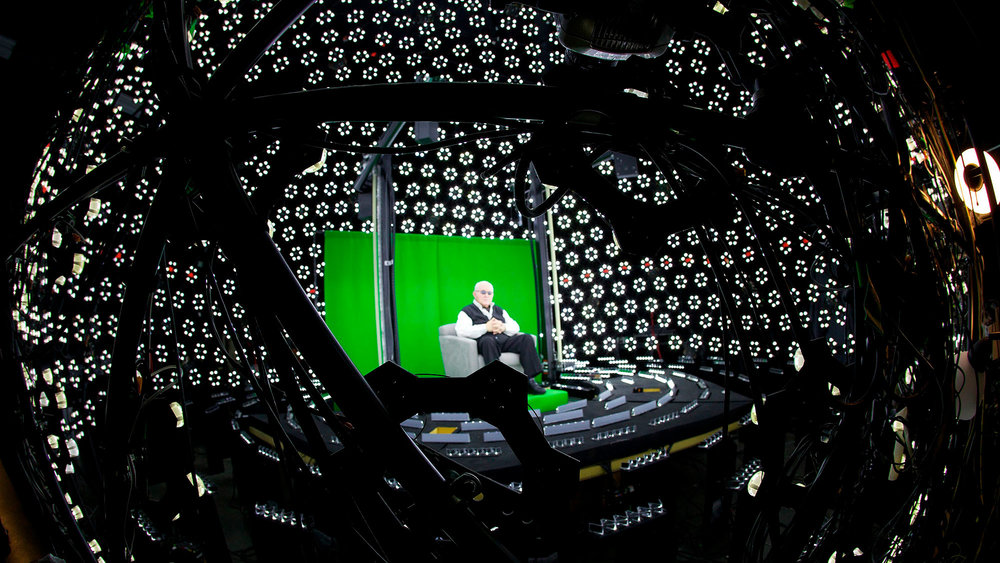This Cleveland tech company is changing the way we experience museums forever
Anyone who has read the works of Elie Weisel or Anne Frank knows that the most powerful way to learn about the horrors of the Holocaust is to hear about it firsthand from a survivor.
Visitors to the Illinois Holocaust Museum and Education Center get an unprecedented chance to do just that, thanks to the work of Cleveland-based company Eventworks 4D (also known as EW4D). In late 2017, the museum debuted the Take a Stand Center—where 3D holograms created by EW4D take the stage to share their experiences and answer audience questions.
"We create a realistic visual perspective that creates the illusion that the audience is talking to a real person onstage," says EW4D president Joel Solloway. "It's a new approach for documenting history in a real-life scenario."
 The first of its kind, the permanent immersive installation has sparked serious interest from other museums around the country, including the Dallas Holocaust Museum (which is building a dedicated hologram theatre set to debut in late 2019). The Smithsonian named it "one of 12 must-see fall exhibits around the world," and British Prime Minister Tony Blair hailed it as "unlike anything [he'd] ever seen."
The first of its kind, the permanent immersive installation has sparked serious interest from other museums around the country, including the Dallas Holocaust Museum (which is building a dedicated hologram theatre set to debut in late 2019). The Smithsonian named it "one of 12 must-see fall exhibits around the world," and British Prime Minister Tony Blair hailed it as "unlike anything [he'd] ever seen."
And as EW4D founder Joel Solloway sees it, this is just the beginning, as he believes the applications for this type of historical documentation are endless.
“This is a technology for living history,” says Solloway. “For instance, we could film Barack Obama and move this into a presidential library. 100 years from now, people could still have a conversation with him and ask about policy or what it was like to live in the White House; it would be like you or I sitting down with the real Abraham Lincoln. This changes the course of the way history will be forever documented.”
In the near future, Solloway can also see this type of hologram translating to “so many other disciplines.” Picture lifelike holographic assistants giving directions in airports, medical centers, and convention center lobbies; holographic librarians helping track down books; or holographic astronauts captivating crowds at planetariums. Thanks to an option called “telepresence,” holograms can even be beamed from one location to another, so Solloway envisions CEOs giving global onstage presentations to multiple locations from the solitary comforts of EW4D’s Cleveland filming room.
"There really are no limitations to how you can customize this technology," says Solloway.
Right now, Solloway is also energized by possibilities in the music industry. “Rock-and-roll icons are aging and dying, but by profiling them as living legends, they are always with us—not just as something we see on a 2D screen or video documentary,” says Solloway.
So how does it work? Solloway says the holograms utilize an artificial intelligence method called natural language processing to essentially program the hologram to converse in a natural and spontaneous manner. In the case of the Holocaust exhibit, the sponsoring Shoah Foundation interviewed 13 real-life survivors (one of whom is from Northeast Ohio, but most from Skokie, IL) to gather stories, voice patterns, and intelligence.
As a result, each individual hologram in the exhibit can answer approximately 2,000 questions in conversation. Along with what Solloway calls “defining questions” (such as “How old were you when you were interred at Auschwitz?”), the cloud-based algorithm ensures that holograms can also answer questions like, “How does it feel to be a hologram?” or "Where do you live now?"
“We want to make sure they can answer humorous questions or questions that address what happened in their life timeline beyond their years in concentration camps,” explains Solloway.
Solloway says this type of organic dialogue is what sets apart EW4D’s work from other companies in the virtual and augmented reality spaces. “Holographic illusion is the visual backbone of what we do, but when you make it interactive, it changes the dimension,” he says. “With our technology, you don’t need [lenticular] glasses or screens—it’s just you in the real world.”
According to Solloway, EW4D is one of just a few companies in the country currently specializing this type of technology with “very limited competition.” Small and mighty with just five employees, EW4D does work all over the globe, but has worked locally with clients like Dealer Tire, Cleveland Clinic, and MetroHealth. Though the company has been around since 1994, EW4D made the transition into what Solloway calls the “holographic world” in 2007.
As they work to expand the technology's reach, Solloway says one of the biggest challenges will be convincing "living legends" to be immortalized in holographic form for historical preservation.
"Once they pass on, their stories can't be told in first person—it makes little sense to do a digital resurrection to bring back someone from the dead," says Solloway. "We have to confront the living and get them to embrace this technology so future generations can truly enjoy the significance they have given to our world."


